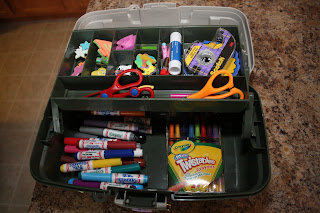


"What is the greatest sign of success for a teacher transformed? It is to be able to say, 'The children are now working as if I did not exist.'" ~Maria Montessori






All of these books (and more) are available for current families to borrow from the school's lending library. See the parents' page of our school website for a full list of books and DVDs.
The child should love everything he learns. Whatever is presented to him must be made beautiful and clear. Once this love has been kindled, all problems confronting the educationalist will disappear.






Encourage your budding artist by helping him keep it neat. Rotate the supplies every few weeks to keep the activity fresh.
Don't get me wrong, I do see the importance of computers in the classroom, but I don't feel that now is a good time to introduce them. Maybe next year?
2. A very kind volunteer has chosen to cut paper for the daily calendar activity. Thank you for your help!

Some helpful tips:
 In order to implement the Daily Calendar Page, every day one student is chosen to write the date on a small piece of paper. That child would then draw the weather of the day or a picture of the current holiday on that piece of paper. The teacher would then take the piece of paper and hang it on a wire that is affixed to the wall. Each day, a new calendar page is added. By June, a beautiful time line of the year is displayed along the walls of the entire classroom. The purpose of this activity is to give the child a concrete representation of the passage of time.
In order to implement the Daily Calendar Page, every day one student is chosen to write the date on a small piece of paper. That child would then draw the weather of the day or a picture of the current holiday on that piece of paper. The teacher would then take the piece of paper and hang it on a wire that is affixed to the wall. Each day, a new calendar page is added. By June, a beautiful time line of the year is displayed along the walls of the entire classroom. The purpose of this activity is to give the child a concrete representation of the passage of time.Currently, those are the only programs that G is permitted to watch. We try to sit with her so that we can discuss anything that might need clarification. We're fortunate enough to have a DVR, so we record these programs each day and G chooses her show before bed. Our schedule works well like this because TV slows her down. Although, this time slot would not work well for those children who get wound up by television. I must admit, Mister Rogers was my favorite program as a child and I still enjoying watching him to this day. I swear, he missed his calling as a Montessori teacher!


In order to avoid boredom and misuse of the materials, switch up the containers once every three weeks or so. Always follow these steps when presenting work at home:
Hopefully, if the work is developmentally appropriate and you've presented it in a way that intrigues him, he'll choose the lesson at another time and repeat it until mastered. You can see a common theme here: observe, observe, observe! These are the steps that Montessori teachers use each time a material is presented. Typically, teachers recommend for parents to only put out practical life and sensorial materials at home, so as not to interfere with the order of the academic lessons.